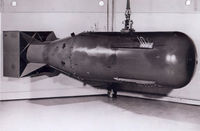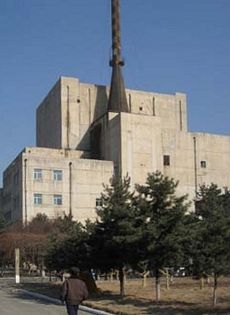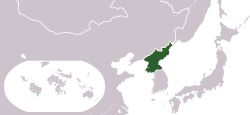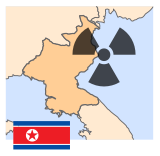كوريا الشمالية وأسلحة الدمار الشامل
| كوريا الشمالية North Korea | |
|---|---|
| Nuclear program start date | 1956 |
| First nuclear weapon test | 9 أكتوبر 2006 |
| Last nuclear test | 25 مايو 2009[1] |
| Largest yield test | 2~6 kt (The yield is disputed. The North-Korean government never announced the exact yield.[2]) |
| Total tests | 2 |
| Current stockpile | 6-8 أسلحة نووية (تقديرا)[3] |
| Maximum missile range | 4,000 km (BM25 Musudan) |
| NPT signatory | نعم، لكنها انسحبت في عام 2003 |
| الأسلحة النووية |
|---|
 |
| خلفية |
| الدول المسلحة نووياً |
|
| كوريا الشمالية ونزع أسلحة الدمار الشامل | |
|
أحداث أسلحة انظر أيضا | |
أعلنت كوريا الشمالية (رسمياً جمهورية كوريا الشعبية الديمقراطية)عن امتلاكها أسلحة نووية كما يعتقد الكثيرون عن إمتلاكها تلك الأسلحة. وقد أكدت وكالة المخابرات المركزية أن كوريا الشمالية تمتلك ترسانة ضخمة من أسلحة كيميائية.
الأسلحة النووية
خلفية
التسلسل الزمني للأحداث
البلوتونيوم

5 MWe experimental reactor at Yongbyon Nuclear Scientific Research Center
North Korea has had two operating reactors, both located at the Yongbyon Nuclear Scientific Research Center.
اليورانيوم المخصب والمساعدات الخارجية
العلاقات مع الولايات المتحدة
الردع النووي
إعادة تنشيط
ادعاءات الإندماج النووي
الأسلحة البيولوجية والكيميائية
أنظمة التسليم
التاريخ
الإختبارات
أوائل ال2000
2009
الهدف
أنظمة التسليم
التجارب الناجحة
التجارب الفاشلة / تجارب لم تختبر
الصادرات
شركاء التصدير
 پاكستان
پاكستان- North Korean entities continued to provide assistance to Pakistan's ballistic missile program during the first half of 1999. Such assistance is critical for Islamabad's efforts to produce ballistic missiles. In April 1998, Pakistan flight-tested the Ghauri MRBM, which is based on North Korea's Nodong missile. Also in April 1998, the US imposed sanctions against Pakistani and North Korean entities for their role in transferring Missile Technology Control Regime Category I ballistic missile-related technology.[4]
 كوبا
كوبا- No confirmed information for North Korea shipping Hwasong-6 missiles to Cuba.[5]
 مصر
مصر- Egypt has received technologies and assistance for making both the Hwasong-5 and Hwasong-6, and may have as well provided guidance systems or information on longer-range missiles to North Korea from its Condor program.
 إثيوپيا
إثيوپيا- Unconfirmed information for possessing Hwasong-5 missiles.[6]
 إيران
إيران- One of the first buyers of North Korean missiles. Iran has established local production for the Hwasong-5 (Shahab-1), Hwasong-6 (Shahab-2) and the Rodong-1 (Shahab-3). Also possesses some 18 land-based BM25 missiles.[7] North Korean weapons sales to Iran are estimated to total $2 billion annually.[8]
 ليبيا
ليبيا- Libya during the reign of Muammar Gaddafi had been known to receive technological assistance, blueprints and missile parts from North Korea.[9]
 نيجريا
نيجريا- In January 2004, the Nigerian government announced that North Korea agreed to sell it missile technology, but a month later Nigeria rejected the agreement under US pressure.[10]
 الكونغو
الكونغو- There is some (although unconfirmed) information, that the Republic of the Congo has acquired Hwasong-5 missiles.[6]
 السودان
السودان- There is some information that Syria shipped some of its North Korean designed Scud missiles to Sudan in 2004.[11]
 سوريا
سوريا- Uses two types of North Korean missiles – the Hwasong-6 and Rodong-1.[11]
 الإمارات العربية المتحدة
الإمارات العربية المتحدة- 25 Hwasong-5s purchased from North Korea in 1989. The Military of the United Arab Emirates were not satisfied with the quality of the missiles, and they were kept in storage.[12]
 ڤيتنام
ڤيتنام- Acquired Hwasong-5/6 missiles in 1998.
 اليمن
اليمن- Known to have bought Hwasong-5 missiles from the DPRK in the 1990s – a total of 15 missiles, 15 TELs with 15 HE warheads.[13]
أنظر أيضا
- الطاقة النووية في كوريا الشمالية
- علاقات خارجية لكوريا الشمالية
- العلاقات بين كوريا الشمالية والولايات المتحدة الأمريكية
- قائمة موضوعات كوريا الشمالية
المصادر
- ^ خطأ استشهاد: وسم
<ref>غير صحيح؛ لا نص تم توفيره للمراجع المسماةUSGS 2009 Quakes - ^ Park, Jeffrey (2009-05-26). "The North Korean nuclear test: What the seismic data says". "Bulletin of the Atomic Scientists". Retrieved 2009-05-28.
{{cite web}}: External link in|publisher= - ^ (إنگليزية)National Geographic, August 2006.
- ^ Report to Congress, January – June 1999. Unclassified Report to Congress on the Acquisition of Technology Relating to Weapons of Mass Destruction and Advanced Conventional Munitions. Central Intelligence Agency.
- ^ Hwasong-6
- ^ أ ب Hwasong-5 information
- ^ The Global Range of Iran's Ballistic Missile Program, Jerusalem Center for public affairs
- ^ The Chosun Ilbo, "North Korea Earning $2 Billion a Year in Arms Deals with Iran", July 16, 2009.
- ^ IISS report
- ^ North Korea Missile Milestones – 1969–2005
- ^ أ ب NTI Country overviews:Syria
- ^ Bermudez, Joseph S. (1999). "A History of Ballistic Missile Development in the DPRK: First Ballistic Missiles, 1979–1989". James Martin Center for Nonproliferation Studies. Retrieved on February 14, 2008.
- ^ [1]
وصلات خارجية
- Federation of American Scientists guide to North Korean chemical weapons
- Jonathan D. Pollack, "North Korea's Nuclear Weapon Development: Implications for Future Policy" Proliferation Papers, Paris, Ifri, Spring 2010
- North Korea's missile arsenal– Key facts (based on South Korean defense ministry data); AFP, June 1, 2005
- North Korea: Problems, Perceptions and Proposals– Oxford Research Group, April 2004
- Second nuclear test conducted by North Korea on May 25, 2009
- Nuclear Files.org Information on the North Korean nuclear program including links to source documents
- [2]
- Annotated bibliography for the North Korean nuclear weapons program from the Alsos Digital Library
- A.Q. Khan hand in North Korea bomb, by Venkatesan Vembu, Daily News & Analysis, October 10, 2006
- The February 13 Action Plan and the Prospects for the North Korean Nuclear Issue – analysis by Narushige Michishita, IFRI Proliferation Papers n° 17, 2007
- North Korean International Documentation Project Contains primary source documents related to the DPRK's efforts to obtain nuclear technology dating back to the mid 1960s
- TIME Archives A Collection of stories regarding North Korea's Nuclear Program
- Chung Min Lee, "The Evolution of the North Korean Nuclear Crisis: Implications for Iran", Proliferation Papers, Paris, Ifri, Winter 2009
- Norris, Robert S. and Kristensen, Hans M., "North Korea’s nuclear program, 2005", "The Bulletin of the Atomic Scientists, May/June 2005
- The Woodrow Wilson Center's Nuclear Proliferation International History Project The Wilson Center's Nuclear Proliferation International History Project contains primary source material relating to North Korea's nuclear weapon program.
الكلمات الدالة:



